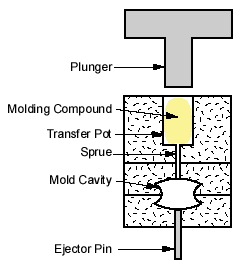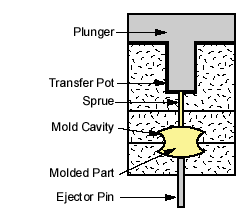Introduction to Transfer Molding
Transfer molding is similar to compression molding in that a carefully calculated, pre-measured amount of uncured molding compound is used for the molding process. The difference is, instead of loading the polymer into an open mold, the plastic material is pre-heated and loaded into a holding champer called the pot. The material is then forced/transferred into the pre-heated mold cavity by a hydraulic plunger through a channel called sprue. The mold remains closed until the material inside is cured.
Transfer molded parts inherently have less flash (excess material that runs along the parting line of the mold) than their compression molded counterparts because the mold remains closed when the plastic enters the mold cavity. However, transfer molding still produces more waste material than compression molding because of the sprue, the air holes and the overflow grooves that are often needed to allow air to escape and material to overflow.
 |
1.The pre-heated, uncured molding compound is placed in the transfer pot. |
 |
2.A hydraulically powered plunger pushes the molding compound through the sprue(s) into the pre-heated mold cavity. The mold remains closed until the material inside is cured (thermosets) or cooled (thermoplastics). |
 |
3.The mold is split to free the product, with the help of the ejector pins. |
 |
4.The flash and sprue material is trimmed off. |
One of the key advantages of transfer molding over compression molding is that different inserts, such as metal prongs, semiconductor chips, dry composite fibers, ceramics, etc., can be placed/positioned in the mold cavity before the polymer is injected/drawn into the cavity. This ability makes transform molding the leading manufacturing process for integrated circuit packaging and electronic components with molded terminals, pins, studs, connectors, and so on.
In the composite industry, fiber-reinforced composites are often manufactured by a processed called Resin Transform Molding (RTM). Layers of textile preforms (long fibers woven or knitted in patterns) are pre-arranged in the mold. The resin is then injected to impregnate the performs. Valcuum is often used to avoid air bubbles and help draw the resin into the cavity. In addition, the resin used has to be relatively low in viscosity.
Although transfer molding can also be used for thermoplastics, the majority of the materials used in this process are still thermosets, Some common ones are:
Epoxy
Polyester (Unsaturated)
Phenol-formaldehyde Plastic (PF, Phenolic)
Silicone rubber (SI)
Pros and Cons of Transfer Molding
Pros
Product consistency better than compression molding, allowing tighter tolerance and more intricate parts
Production speed higher than compression molding
Fast setup time and lower setup costs than injection molding
Lower maintenance costs than injection molding
Ideal for plastic parts with metal inserts
Cons
Wastes more material than compression molding (scraps of thermosets are not re-useable).
Production speed lower than injection molding

